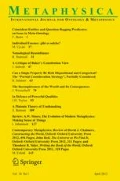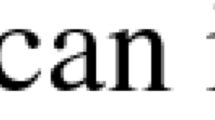Abstract
This paper discusses a problem for Russellian propositions. According to Russellianism, each word in a sentence contributes its referent to the proposition expressed by the sentence. Russellian propositions have normally been conceived of as problematic for two reasons, viz. they cannot account for the unity of the proposition and they have problems with non-referring singular names. In this paper, I argue that Russellianism also faces a problem with respect to properties. It is inconsistent with both traditional realism and trope-theories. The only theory of properties which is consistent with Russellianism is Platonism. Moreover, it is argued that Russellianism needs a particularly implausible version of Platonism.
Similar content being viewed by others
Notes
Oddly enough, Neo-Russellianism should properly speaking be called Neo-Meinongianism, since Russell seems to have got his notion of proposition from Meinong’s notion of objective! As Candlish (2007:58f) points out, when Russell criticises his own early theory of propositions as outlined in Principles of Mathematics (Russell 1903), the criticism is explicitly directed at Meinong, rather than at his own earlier theory. (Russell 1910:150ff) The first edition of Über Annahmen, the work where Meinong presents his theory of objectives, was published in 1902 (Meinong 1902, Meinong 1983), thus a year before Russell launched the theory.
Russell’s theory became more and more complex during the years that followed the 1910 account in order to account for various problems that the 1910 account gave rise to. But he did not abandon the idea that the constituents of the proposition are united in virtue of being related to the mind of the judger until 1919. (Cf Candlish 2007:ch 3 for a good survey of his development).
A terminological note: When using the term “predicate”, I shall refer to predicate words and predicate expressions and not to the meaning, reference or extension of these words.
With “normal referents” I mean objects and properties in spacetime. The qualification “normal” is included so as not to construe a desideratum which automatically rejects theories that postulate the existence of various Ersatz-entities such as non-existent entities, Platonic forms or various abstract entities as referents of words lacking referents in spacetime.
On some accounts, some propositions lack truth-value altogether. (1) is formulated so as neither to preclude nor entail this position.
This is not strictly speaking true as Russell admits that Bismarck could enter as a constituent in a proposition entertained by Bismarck himself, but not by any other person.
If you are not a realist about colours, the same kind of example can be construed with respect to other properties. Nothing important hinges in other words on colour realism.
It is important to note that on Soames account predication is an intensional notion. Predication is the tie or connection that unites the constituents of a proposition to a unity. So when we judge or claim that an object has a property, the property is predicated of the object. Obviously, this does not entail that the object instantiates the property. Predication is a purely semantic notion. We shall follow Soames in this respect in this paper.
It could be argued that the relational properties referred to in (5) and (5′) are not basic, but rather a complex of various basic properties. The example could however easily be rewritten. Let us assume that Alan is the only individual in spacetime to exemplify the properties of weighing exactly 63.567888 kg and having a determinate colour red, that we might call “red22”. If that is the case, the class of all objects weighing exactly 63.567888 kg coinicides with the class of all objects being red22. Combining class nominalism with Russellianism, we would then end up with a situation in which the sentence “Alan weighs 63.567888 kg” express the same proposition as “Alan is red22”. But this is clearly absurd.
(3) Any object weighing 7.123123123 kg is heavier than any object weighing 5 kg.
I am now assuming that Kripke’s argument against the possible existence of unicorns is correct (Kripke 1980: 156ff).
(4) The ball is blue.
References
Armstrong, D. M. (1978). Universals and Scientific Realism: Nominalism and Realism, Vol I., Cambridge: Cambridge University Press.
Campbell, J.K., O’Rourke, M., Shier, D. (Eds) (2002), Meaning and Truth. Investigations in Philosophical Semantics, New York and London: Seven Bridges Press.
Candlish, S. (2007), The Russell/Bradley Dispute and its Significance for Twentieth-Century Philosophy, Hampshire and New York: MacMillan.
Fitch, G. and Nelson, M. (2009), “Singular Propositions”, The Stanford Encyclopedia of Philosophy (Spring 2009 Edition), Edward N. Zalta (ed.), URL=<http://plato.stanford.edu/archives/spr2009/entries/propositions-singular/>.
Gaskin, R. (2008), The Unity of the Proposition, Oxford, New York: Oxford University Press.
Husserl, E. (1984). Logische Untersuchungen. Zweiter Band, Hrsg. U. Panzer, The Hague, Boston and Lancaster: Martinus Nihjoff.
Husserl, E. (2001), Logical Investigations Volume 2, translated by J. N. Findlay, London: Routledge.
Johansson, I. (2000), “Determinables as Universals,” The Monist, 83:101–121.
Johnson, W.E. (1921). Logic part I, Cambridge: Cambridge University Press.
King, J. C. (2008), “Structured Propositions”, The Stanford Encyclopedia of Philosophy (Fall 2008 Edition), Edward N. Zalta (ed.), URL=<http://plato.stanford.edu/archives/fall2008/entries/propositions-structured/>.
King, J. (2009), The Nature and Structure of Content. Oxford: Oxford University Press.
Kripke, S. (1980), Naming and Necessity, Cambridge, Massachussetts: Harvard University Press.
Lewis, D. (1983), “New Work for a Theory of Universals”, Australasian Journal of Philosophy, 61:343–77.
Meinong, A. (1902), Über Annahmen, Leipzig: J. A. Barth.
Meinong, A. (1983), On Assumptions, English translation of the second edition of Meinong (1902), translated, edited and introduced by James Heanue. Berkeley: University of California Press.
Mertz, D. W. (1996), Moderate Realism and Its Logic. New Haven: Yale University Press.
Mulligan, K. (1988), “Judgings: Their Parts and Counterparts”, Topoi Supplementa 2:117–148.
Rodriguez-Pereyra, G., (2002), Resemblance Nominalism. A solution to the problem of universals, Oxford: Clarendon Press.
Russell, B. (1903), Principles of Mathematics, second edition (1937), London: George Allen and Unwin.
Russell, B. (1910), “On the Nature of Truth and Falsehood”, in Russell 1966:147–159.
Russell, B. (1911), “Knowledge by Acquaintance and Knowledge by Description”, in Russell 1917:209–232.
Russell, B. (1917), Mysticism and Logic and Other Essays, London: George Allen and Unwin.
Russell, B. (1966), Philosophical Essays, second edition, London: George Allen and Unwin.
Russell, B. (1984), Theory of Knowledge. The 1913 Manuscript, London: George Allen and Unwin.
Salmon, N. (1986), Frege’s Puzzle, Atascadero: Ridgeview.
Salmon, N. (1998), “Nonexistence”, Noûs 32:277–319.
Salmon, N. (2002), “Mythical Objects”, in Campbell, O’Rourke, Shier (eds) 2002: 105–123.
Searle, J. (2008), “The Unity of the Proposition”, in Searle 2008:181–196.
Searle, J.R. (2008), Philosophy in a New Century, Cambridge: Cambridge University Press.
Soames, S. (2002), Beyond Rigidity. The Unfinished Semantic Agenda of Naming and Necessity, Oxford and New York: Oxford University Press.
Soames, S. (2010), What is Meaning?, Princeton and Oxford: Princeton University Press.
Svennerlind, C. (2008), Moderate Nominalism and Moderate Realism, Gothenburg: Acta Philosophica Gothoburgenisa.
Williams, D. C., (1953), “On the Elements of Being: I.” The Review of Metaphysics, Vol. 7:3–18.
Acknowledgements
I have learned a lot during the last years from conversation with Christer Svennerlind on all things metaphysical and from Alexander Almér on all things semantical. Thanks are due to both of them for comments on drafts of this paper. Thanks are also due to Ingvar Johansson and Kent Gustavsson for many valuable comments on this paper.
Author information
Authors and Affiliations
Corresponding author
About this article
Cite this article
Almäng, J. Russellian Propositions and Properties. Int Ontology Metaphysics 13, 7–25 (2012). https://doi.org/10.1007/s12133-011-0089-z
Published:
Issue Date:
DOI: https://doi.org/10.1007/s12133-011-0089-z




